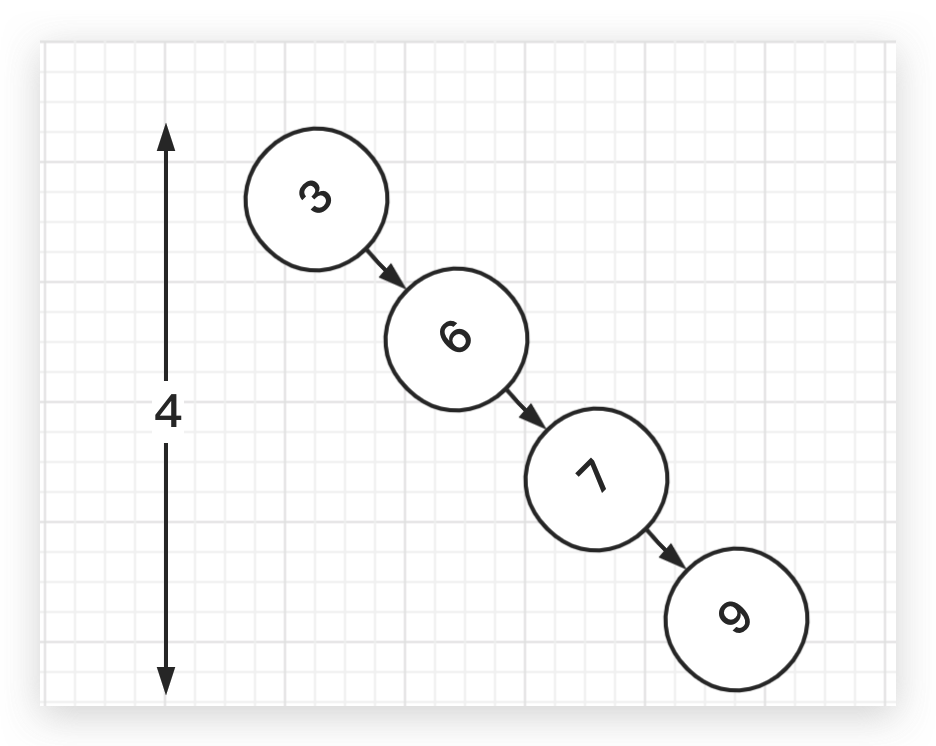Problem Description 给定一个 n x nk 小的元素。k 小元素,而不是第 k 个不同的元素。
note 你可以假设 k 的值永远是有效的,1 ≤ k ≤ n ^ 2
e.g.
示例:
1 2 3 4 5 6 7 8 matrix = [ [1, 5, 9], [10, 11, 13], [12, 13, 15] ], k = 8, 返回 13。
Solution 有一说一,被二维数组中的查找 这道题整魔怔了。该题目的一种解法 是将该矩阵模拟成一个二叉搜索树,利用其性质来做遍历方向的决策从而快速找到target。因为是模拟二叉搜索树,所以查找的时间复杂度是O (log(n ^ 2 ) )害挺快的。而这题也是同样的矩阵,但求的是第k个值(排序好的第K位)。
刚好晚上看了麻省理工公开课的其中一节课(二叉搜索树和快排) 。认识到了二者相似性和奇妙之处。二叉搜索树的构建过程和快排的排序过程,二者在最坏的情况下时间复杂度都是O (n ^ 2 ) ,平均时间复杂度都是O (nlog(n ) ),原理十分类似。BST在最差的情况是什么呢?就是像链表一样的情况,只有左节点或者右节点,这样它的高度就是节点数量(N),而在满二叉树下它的高度是(logN)。所以N个元素在构建BST的过程中,会先查找它应该在的位置(logN),N个元素就是O (nlog(n ) )。但是在有序的数列(正、逆序)中会出现很糟糕的情况,这点和快排的pivot的选择很像。
所以这道题我就在想可不可以利用BST的中序遍历的结果来求第K个元素?该矩阵的特性很像BST,因为该矩阵的扁平成一维数组的结果对于构建BST应该是比较理想的,不可能出现上图的这种情况。
我的思路:
将矩阵遍历,添加到一个新数组中;
将该序列构建BST(新的序列对于构建BST是理想的);
对该BST中序遍历,结果放在一个新数组中;
得到该新数组的第k个元素。
先将该矩阵的元素来构建一颗二叉搜索树。以下是二叉树模型:
1 2 3 4 5 6 7 8 9 10 11 12 13 14 15 16 17 18 19 public class TreeNode { public int val; public TreeNode left; public TreeNode right; public TreeNode (int x) { val = x; } @Override public String toString () { return "TreeNode{" + "val=" + val + ", left=" + left + ", right=" + right + '}' ; } }
通过深度优先遍历的方式,对矩阵的右上角向左向下 遍历,为了不出现重复访问,设置一个visited访问标记。类似先序遍历:
1 2 3 4 5 6 7 8 public static void dfs2 (int [][] matrix, int x, int y, boolean [][] visited, List<Integer> res) { if (x >= 0 && y >= 0 && x < matrix.length && y < matrix[0 ].length && !visited[x][y]) { visited[x][y] = true ; res.add(matrix[x][y]); dfs2(matrix, x - 1 , y, visited, res); dfs2(matrix, x, y + 1 , visited, res); } }
接下来就是构建BST的过程代码辣:
1 2 3 4 5 6 7 8 9 10 11 12 13 14 15 16 17 18 public static void buildBst (int n, TreeNode root) { if (n <= root.val) { if (root.left == null ) { root.left = new TreeNode (n); } else { root = root.left; buildBst(n, root); } } else { if (root.right == null ) { root.right = new TreeNode (n); } else { root = root.right; buildBst(n, root); } } }
然后是对BST的中序遍历,BST的中序遍历打印的结果,一定是升序的。
1 2 3 4 5 6 7 public static void dfs (TreeNode root, List<Integer> res) { if (root != null ) { dfs(root.left, res); res.add(root.val); dfs(root.right, res); } }
其中要注意root节点在构建之前就已经创建了,所以第一个遍历的数组下标从1开始遍历,完整的代码:
1 2 3 4 5 6 7 8 9 10 11 12 13 14 15 16 17 18 19 20 21 22 23 24 25 26 27 28 29 30 31 32 33 34 35 36 37 38 39 40 41 42 43 44 45 46 47 48 49 50 51 52 53 54 55 56 57 58 59 60 61 62 63 64 65 66 67 68 69 70 71 72 73 public class KthSmallestElementInaSortedMatrix { public static int kthSmallest (int [][] matrix, int k) { List<Integer> tmp = new ArrayList <>(); List<Integer> res = new ArrayList <>(); boolean [][] visited = new boolean [matrix.length][matrix[0 ].length]; dfs2(matrix, matrix.length - 1 , 0 , visited, tmp); TreeNode root = new TreeNode (tmp.get(0 )); for (int i = 1 ; i < tmp.size(); i++) { buildBst(tmp.get(i), root); } dfs(root, res); return res.get(k - 1 ); } public static void buildBst (int n, TreeNode root) { if (n <= root.val) { if (root.left == null ) { root.left = new TreeNode (n); } else { root = root.left; buildBst(n, root); } } else { if (root.right == null ) { root.right = new TreeNode (n); } else { root = root.right; buildBst(n, root); } } } public static void dfs (TreeNode root, List<Integer> res) { if (root != null ) { dfs(root.left, res); res.add(root.val); dfs(root.right, res); } } public static void dfs2 (int [][] matrix, int x, int y, boolean [][] visited, List<Integer> res) { if (x >= 0 && y >= 0 && x < matrix.length && y < matrix[0 ].length && !visited[x][y]) { visited[x][y] = true ; res.add(matrix[x][y]); dfs2(matrix, x - 1 , y, visited, res); dfs2(matrix, x, y + 1 , visited, res); } } } class TreeNode { public int val; public TreeNode left; public TreeNode right; public TreeNode (int x) { val = x; } @Override public String toString () { return "TreeNode{" + "val=" + val + ", left=" + left + ", right=" + right + '}' ; } }
最后,当然性能拉胯了。。这只是一种奇葩做法。。
